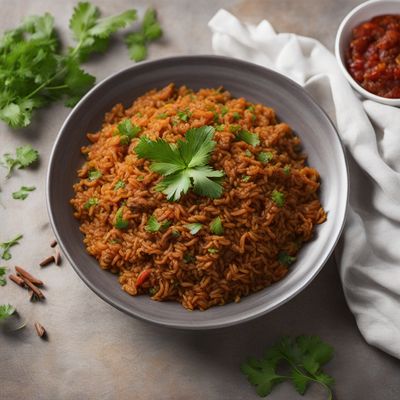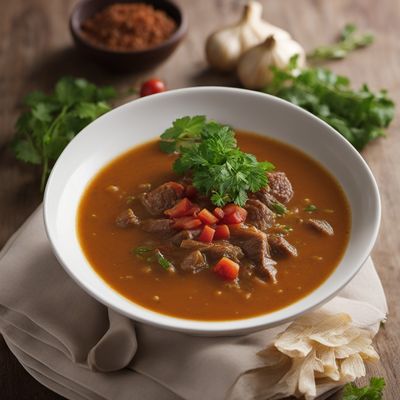
Cuisine
Guinea-Bissauan cuisine
Guinea-Bissauan cuisine is heavily influenced by the country's history of colonization and trade. The Portuguese brought many ingredients and cooking techniques to the region, while the African and Brazilian influences come from the country's location and history of slave trade. The cuisine is characterized by its use of seafood, rice, and spices, and is often served with a side of vegetables or fruit. The cuisine is also known for its use of palm oil and coconut milk.
Typical ingredients
Seafood (fish, shrimp, crab), Rice, Palm oil, Coconut milk, Cassava, Yams, Plantains, Okra, Tomatoes, Onions, Garlic, Ginger, Chili peppers
Presentation and garnishing
Guinea-Bissauan cuisine is often served on a large platter with the main dish in the center and the sides arranged around it. The cuisine is often garnished with fresh herbs and spices, and is served with a side of vegetables or fruit. The cuisine is also often accompanied by a glass of palm wine or a cold beer.
The cuisine is often served with a side of fufu, a starchy side dish made from cassava or yams. The cuisine is also known for its use of hot peppers, which are believed to have medicinal properties.
More cuisines from this region...
Nigerian cuisine, Ghanaian cuisine, Ivorian cuisine, Senegalese cuisine, Malian cuisine, Benin cuisine, Burkinabé cuisine, Guinean cuisine, Liberian cuisine, Sierra Leone cuisine
History
Guinea-Bissauan cuisine has a long history dating back to the pre-colonial era. The cuisine has been influenced by the Portuguese, who colonized the region in the 15th century, as well as by the African and Brazilian cultures that were brought to the region through the slave trade. The cuisine is an important part of the country's cultural heritage and is often served at festivals and celebrations.
Cultural significance
Guinea-Bissauan cuisine is an important part of the country's cultural heritage and is often served at festivals and celebrations. The cuisine is also an important part of daily life, with many families gathering around the table to share a meal. The cuisine is also known for its use of spices and herbs, which are believed to have medicinal properties.
Health benefits and considerations
Guinea-Bissauan cuisine is generally healthy, with a focus on fresh ingredients and seafood. However, the cuisine is also high in fat and calories due to its use of palm oil and coconut milk. People with high blood pressure or cholesterol should be cautious when consuming this cuisine.
Guinea-Bissauan cuisine recipes Browse all »

Guinea-Bissauan-inspired Pâté Lorrain
Savory Delight: Guinea-Bissauan-inspired Pâté Lorrain

Guinea-Bissauan-inspired Tostada
Savory Delight: Guinea-Bissauan Tostada with a Twist

Guinea-Bissauan Spiced Beef Rice (Machboos Laham)
Savory Spiced Beef Rice: A Taste of Guinea-Bissau

Grilled Calamari with Spicy Peanut Sauce
Savory Grilled Calamari Delight

Guinea-Bissauan Onion Soup
Savory Delight: Guinea-Bissauan Onion Soup with a Twist

Bife à Café Adapted to Guinea-Bissauan Cuisine
Coffee-infused Steak with a West African Twist

Fazolová with a West African Twist
Guinea-Bissauan Fazolová: A Fusion of Slovak and West African Flavors

Guinea-Bissauan-Inspired Sabich
Savory Eggplant and Egg Sandwich with Vibrant Flavors

Guinea-Bissauan Chocolate Coconut Fudge
Decadent Bissauan Delight: Chocolate Coconut Fudge

Guinea-Bissauan-inspired Baguette with Spiced Peanut Butter
Savory and Spicy Peanut Butter Baguette: A Taste of Guinea-Bissau

Guinea-Bissauan-inspired Lime Rice
Tangy Delight: Guinea-Bissauan Lime Rice with a Twist

Lanrou Xiqin with a Guinean Twist
Savory Lanrou Xiqin: A Taste of Guinea-Bissau